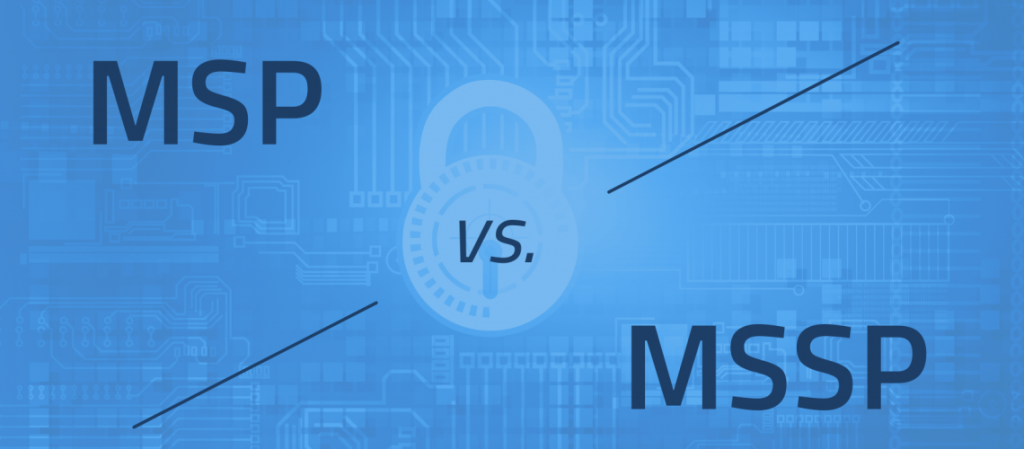A Managed Service Provider (MSP) and a Managed Security Service Provider (MSSP) are very different, and many small businesses and large corporations are curious about the key differentiators. An MSP makes sure your IT systems are operational and useful to clients and customers. The focus is mainly on administrative duties. Businesses tap into MSPs to work on usability and performance issues. An MSSP provides security as a service; it makes sure your team members and systems are secure and in compliance.
MSPs are now prominent in business operations via IT and cloud solutions. MSSPs are desperately needed in the volatile cyber world by dedicated cybersecurity providers. The focus is only on business security and its associated solutions. Customers and team members can tap into information systems with MSSPs.
MSSPs prevent, detect and respond to infrastructure threats impacting networks and applications. Their expertise is in aligning security with compliance frameworks. Incident detection, incident response, and scans for new threats and vulnerabilities are part of their responsibilities.
Organizational security must be shielded from vulnerabilities. MSPs and MSSPs are desperately needed to avoid breaches that can impact profitability. Cybercriminals are relentless and they’re always looking to harvest data by any means necessary. Cybercriminals prefer to attack small businesses because they cannot afford a security team, making them incredibly vulnerable. But a business without cybersecurity is a sitting duck.
Information is the currency of the cyber world, and data is an asset and any leak harms operations and your reputation. Attacks can also destroy devices and leave electronic tools vulnerable.
Small businesses should outsource to protect their information with MSPs and MSSPs. Again, MSPs are for IT admin, and MSSPs are for IT security. MSPs provide easy access to your organization’s IT system and offer bug fixes, update management and threat detection. MSSPs focus on security tools and risk and cyber event management.
The real difference between MSPs and MSSPS
MSPs allow businesses to get through their day and tasks without being interrupted by any breaches via network management, managed mobility, managed communication and cloud management. MSPs usually include software and OS patch management, bug fixes, threat detection, and basic antivirus and antimalware protection as part of their standard cybersecurity services for advanced protection.
On the other hand, some MSSP tools include cutting-edge intrusion detection systems, vulnerability scanners, VPNs, firewalls and dark web scans. These tools carry out holistic threat detection, prevention and mitigation activities for threats of all stages.
The MSP model
Small businesses can contract a third-party vendor for reliable IT services for their infrastructure. These include management of backend IT infrastructure for its clients, like servers, applications and networks. To help operations run smoothly, they can provide native or external tools for scaling. The MSP model is expected to grow from $242.9 billion in 2022 to $354.8 billion by 2026. Businesses understand that to thrive, they must invest in their infrastructure. MSPs offer competitive pricing via bundled services and customized packages and they can also offer a subscription model for secure growth.
Most MSPs work with unified endpoint management (UEM) and remote monitoring, professional service automation (PSA) tools, data backup, and recovery management (RMM) tools to manage IT infrastructures remotely or on premise.
MSP’s seamless integration can save businesses time and money with expertise and proactive support to drive core business initiatives.
The MSSP model
The managed security services market is expected to reach $64 billion in 2026. North America is currently the largest market for the provided 24/7 security monitoring, virus and spam blocking, vulnerability scanning, threat intelligence and intrusion detection, penetration testing, compliance management and perimeter management.
Cybercrime has been up 600% since the pandemic and large corporations have experienced up to 270% of it on average. State-of-the-art cybersecurity tools and processes are now must-haves. Companies are already struggling to keep up with daily IT tasks and are looking at MSSPs to manage their infrastructure in-house or remotely.
Harnessing the power of security operations centers, MSSPs can provide 24/7 cyber protection by analyzing continuous data to prevent, identify and mitigate threats. MSSP is more tactical than advisory.
Companies can use MSSPs to supplement their existing IT teams. There is now a drastic skills gap in the cybersecurity world. Companies cannot fill essential IT positions and have resorted to outsourcing.
MSP
- Drives operational efficiency
- Firewalls, endpoint protection and email filtering
- Patch management, bug fixes and threat detection services
- Help desk, networking and storage
- Remote monitoring and management (RMM) tools to manage computers and networks
- Help clients achieve operational efficiency by properly troubleshooting IT issues and providing timely and accurate assistance
MSSP
- Protects a company’s data, network and endpoints from all kinds of cyberthreats
- Intrusion detection and mitigation, vulnerability scanning, deep web scanning, etc.
- Advanced protection against the most malicious cyberthreats
- Advanced cybersecurity tools
- Security information and event management, SIEM, tools to closely monitor the cybersecurity position of clients
- Clients work with MSSP security analysts who understand the business to develop the right cybersecurity setup
There is a great future with MSPs and MSSPs and now is the time to get upskilled in cybersecurity. Companies are looking to fill the gap in their cyber workforce before their data is compromised. Check out the programs powered by ThriveDX at https://thrivedx.com/


